Alex C. Telander's Blog, page 62
March 12, 2013
Bookbanter Column: Get Lost in a Good Fantasy Series Part 8: The Sarantine Mosaic (October 12, 2012)
Bestselling author Guy Gavriel Kay got his start in writing in an unusual way, working more as an editor with Christopher Tolkien on the numerous volumes of Lord of the Rings and Middle Earth material J R. R. Tolkien wrote during his lifetime.
His first published series was the Fionavar Tapestry trilogy, which falls into a lot of the pitfalls of a stereotypical fantasy series with some weak characters.

But with the release of Tigana in 1991, he began a journey through many worlds and stories with many more books, which are all kind of linked. Tigana is a quasi-medieval Italy, but with alternate, with numerous fantasy elements.
A Song for Arbonne is alternate-medieval France. The Lions of Al-Rassan is sort of medieval Spain. And The Last Light of the Sun is from the time of the Vikings, in a story you likely haven’t read about before.
And then there’s The Sarantine Mosaic, a duology written about the time of the great city of Byzantium with its powerful king and queen, and the chariot races, and the magic that existed there.
These two books, Sailing to Sarantium and Lord of Emperors, do an excellent job of showing Kay at his best blending historical fact and fiction with fantasy and easily transport the reader to another world.
In 2010, Guy Gavriel Kay released Under Heaven, a Chinese historical fiction novel with fantasy elements set in the 8th century Tang Dynasty, and plans to release River of Stars in 2013 set approximately 350-400 years after Under Heaven.
Sailing to Sarantium
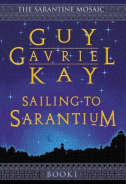
Sailing to Sarantium, the first in the two-part Sarantine Mosaic, is a picturesque and moving adventure of ancient Byzantium, with Guy Gavriel Kay writing at his best.
This is the story of a talented mosaicist, Crispin, who has lost his wife and children to the plague and is looking for something new in his life. He is delivered this opportunity, a chance to create something, a project in the distant and renowned city of Sarantium.
As this is the first part of a two-book series, Kay spends a healthy amount of time exploring his main character and exploring the world he has created, which is a lot like that of the ancient world, but also a wonderful fabrication of Kay’s imagination. Crispin experiences much on his journey to Sarantium: the meeting of an alchemist, a slave girl, and an epiphany where he perhaps comes face to face with an ancient god. The events serve to change Crispin’s outlook on life, but also to let the reader in on his experiences and ideology.
In Sarantium, he tries to keep to himself and his work, but finds himself drawn into political factions, the emperor’s court, and becomes part of the many who seemingly worship the hippodrome and the great chariot races, whose riders are seen as heroes.
Sailing to Sarantium is a great example of Kay’s creative writing, his strong and interesting characters, and his imagined but quite believable world.
Lord of Emperors
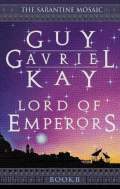
In the concluding volume of the Sarantine Mosaic, after Sailing to Sarantium, we continue where we left off: talented mosaicist Crispin, now Imperial Mosaicist to Valerius II, is working on a magnificent dome for the Emperor and Empress of Sarantium (a fantasy version of ancient Byzantium and Emperor Justinian and Empress Theodora).
But because this is a large, complicated city, and Crispin is now an important person, he finds himself unavoidably inveigled in plots and conspiracies, as the Emperor plans for a war in Crispin’s homeland. Then a new character enters the play, Rustem of Kerkakek, a physician from the eastern desert kingdom of Bassania; a reward for saving his emperor’s life.
Now Sarantium has a host of unusual citizens, while Crispin keeps his allies together – a slave girl and mistress, the exiled queen of Antae, Gisel, and this new and enigmatic character, Rustem.
Guy Gavriel Kay continues to build on the momentum and creativity of Sailing to Sarantium, but also introduces new and interesting characters, as well as creating new plotlines that weren’t visible in the first book.
He does what is key to a sequel: building on the story already established, but at the same time taking the reader down new and undiscovered avenues.


Bookbanter Column: Get Lost in a Good Fantasy Series Part 7: The Kingkiller Chronicles (September 28, 2012)
The Name of the Wind, the first of the Kingkiller Chronicles by Patrick Rothfuss, showed itself to the world in 2007.
It was a story that seemed to have every trope and cliché that epic fantasy is expected to have from an old innkeeper named Kvothe telling his tales of yore, to a magician learning the ways of his craft at a magician’s school . . .
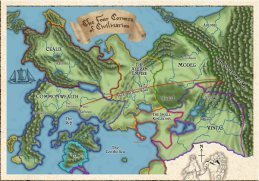
. . . And yet there were also facets of the book that made it fascinating and quickly a bestseller, from Kvothe’s abilities and talents as a musician, to some of the amazing characters and friends he has gotten to know, to the magic itself, as they consider themselves arcanists and the magic feels more like a form of science.
The Name of the Wind spent a good long time on the bestseller lists, and earned the epithet: “Harry Potter for Adults.”
Rothfuss took his time with the second book in the trilogy, The Wise Man’s Fear, which was released in 2011, almost a thousand pages long.
But by the end of the book, there still seems too much story to tell.
Rothfuss maintains that it will only be a trilogy and is hard at work now on the final book, with the planned title of The Doors of Stone, with no known release date. Therefore readers looking for a good new series can take their time with the first two books, as the final volume likely won’t see a release date until possibly late 2013, if not 2014.
The Name of the Wind
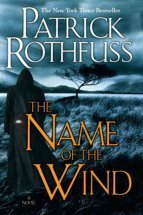
Kvothe begins his story as a young boy in a family of musicians and soon reveals his incredible talent with the lute and singing, following in the family tradition. While mastering these talents a member of the University joins the troop and begins teaching Kvothe a material and science based form of magic, as well as the secret of naming, creating a drive in Kvothe to discover the Name of the Wind.
At the same time, his father Arliden is composing a song about the Chandrian, a mythical race of evil beings who may or may not exist. This is soon proven when the Chandrian find the troop and slaughter them all. Kvothe is the only one to survive, hiding in the woods.
He spends his next three years eking out a living begging and scratching by on the streets of Tarbean, until his interest in magic and study is reignited once more by a storyteller. Using his experience in bargaining and negotiating to survive, Kvothe gets himself into University where he leans all he can while trying to make enough money to cover the tuition by playing and singing. It is while playing he is reunited with an old friend, Denna, who he is very taken with. During his studies, he also begins research on the Chandrian to avenge the death of his parents.
The book comes to a close as Kvothe investigates a place of death and destruction where a wedding was abruptly brought to an end by the Chandrian, coming face to face with a drug-addicted dragon.
At the heart of The Name of the Wind are a lot of almost clichés one would expect with an epic fantasy novel, but at the same time there are a lot of new, refreshing and completely different ideas and plots. The magic of this world – unlike that of say Harry Potter – is one of balance, based in science with quantities and a variety of materials; it is a type of magic that at times seems quite realistic and believable. The world has familiar places but with unique situations and events involving some strong characters and unusual creatures that keep the reader interested.
By the end of the book, the reader has become quite attached to this world and its people, wanting more stories and tales from Kvothe the innkeeper, but alas they must wait until Wise Man’s Fear, due March 2011, hopefully without delay.
The Wise Man’s Fear
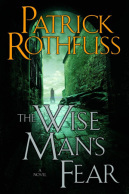
Readers are returned first to Kote at the Waystone Inn with his friend and apprentice, Bast.
A new day begins, after the stories and surprising events of the one before. Chronicler sits ready to record the story, while Kote has already been up many hours, preparing fresh cider and newly baked bread. And so Kote continues the story of his life, the story of Kvothe the arcanist. The sixteen year-old continues his studies at the University, struggling to get by. He has spent his recently acquired monies on a new lute and now has little to show for it, but the instrument is an investment. Now raised to the next level of arcanist, Re’lar, his tuition is considerably higher, and his must borrow money to pay for it.
Fortunately, he has his incredible talent as a musician and singer, and is able to make some money this way through a clever scheme at the inns.
Then there is the Fishery, where all manner of arcana are made. Kvothe has spent previous terms learning and inventing simple items such as sympathy lamps that bring in a decent amount of money, but this term he is challenged to create something truly unique; it will take him many months, but the result will fetch a high price. Kvothe is also finally granted access to the priceless Archives once more, and after learning how to travel its complex, labyrinthine halls, corridors and stacks; begins his incessant research on the unknown Chandrian, for they are the ones who murdered his family and friends. Meanwhile, Kvothe’s relationship with Deanna continues to go nowhere fast, as he does all he can to make her happy and feel special . . . everything that is except confess his love for her. He even breaks into the rooms of his mortal enemy to steal back Deanna’s ring and proceeds to get himself into a whole mess of trouble.
At the end of the term, Kvothe seems to have everything in order, but has a couple of options: he can continue with his studies the following the semester, and risk having the gossip of his involvement jeopardize his studies; or he can leave town and try something different for a while. Fortunately at that moment, there is a rich noble from Vintas looking to woo a certain lady and needs one skilled with words. So begins the second half of the book, as Kvothe is soon on his way and finds himself involved in the noble courts, as a different world is revealed to the reader of manners and ways and courtly intrigue. Kvothe is also employed into a gang to stop a band of bandits terrorizing the tax collectors. In this gang he befriends a unique man and seeks to learn his ways and culture. The question is whether he can understand and learn this man’s language, as well as stop these bandits once and for all. Meanwhile, in the back of his mind, Kvothe wonders and hopes if the rich noble who has employed him may wish to take him on permanently as his patron.
In this thrilling and worthy sequel, Rothfuss does an excellent job of balancing the familiar of The Name of the Wind with plenty of new and fascinating material, furthering the complexity and interest of the world, its people, and its varied cultures and ways. While the heavy tome could’ve stood to lose a few pages in editing, readers will no doubt be delighted with its length and depth. To many – as with this reviewer – this book will exceed their expectations and prove to be an even better episode in the Kingkiller Chronicles than the previous one.
Patrick Rothfuss has proven in Wise Man’s Fear that he can deliver the goods, and while he may need to take his time to get the writing done, the result is an epic giant in the world of fantasy that will be remembered for a long time.


Bookbanter Column: Get Lost in a Good Fantasy Series Part 6: A Song of Ice and Fire (September 21, 2012)
Little did George R. R. Martin originally know that when he started writing A Game of Thrones, the first book in the Song of Ice and Fire series, changing from an idea in his head to something real on paper, that it would become such a bestseller and so popular with readers around the world.
Now with the success of the HBO series, even more people are turning to reading the books for the first time.
But it can be pretty intimidating facing that premiere heavy hardcover tome or that weighty fat paperback for the first time as you begin the series, so here’s a rough breakdown of what happens in the books.

While Martin had originally intended for the series to be trilogy and soon realized it was going to be much longer, the planned length is now seven books, with five books now released and two more to go.
One hopes Martin can reach the end of the series before the HBO TV show catches up with him.
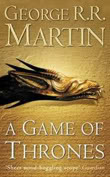
A Game of Thrones: Journey to Westeros for the first time, with A Game of Thrones, but beware for winter is coming.
In the first of George R. R. Martin’s landmark, epic fantasy series, A Song of Ice and Fire, readers will be introduced to a complex world of many lands and many families, with many characters, but have no fear for Martin tells the story from unique viewpoints of different members of different families, forcing the reader to fit the different pieces of the story together, creating the overall puzzle of plot. Readers will be reminded of everything they love about great fantasy stories, whether they be simple or epic; as well as discovering why George R. R. Martin has earned the title of the “American Tolkien.”
In the world of Westeros, there are Seven Kingdoms, long ago independent, now united under the Iron Throne, but those named king never seem to last long in this world of corrupt, power-hungry families. There are two main families which readers are first introduced to: the Starks and the Lanisters, emulating the Wars of the Roses with the Yorks and Lancasters. With the Starks there is proud and strong Ned, who is to be the King’s Hand to Robert Baratheon, and his determined and caring wife, Catelyn. The sons are Rob, the eldest, Jon Snow, a bastard, Bran who suffers a debilitating accident, and Rickon who is too young to really understand what is going on. The daughters are Sansa, who is a young, fair maiden always looking for her knight in shining armor to whisk her off her feet; and Arya, who is boyish and wants to learn how to fight with a sword, ride a horse into battle, and defend herself. The Lannisters are a different type of family, constantly looking for gain whether it is with land, riches, or power. At the head of the household is the aging Lord Tywin, with his children: the beautiful, blond and blue-eyed Jaime and his twin Cersei – who share much more than a sibling affection – and little Tyrion, a dwarf who has had to fight for everything in his entire life. Cersei is wife to the king, Robert Baratheon, and together they have young Joffrey, heir to the throne, along with Tommen and Myrcella.
While tension builds between the families at King’s landing, far to the north lies the Wall – 700 feet tall and 300 miles long, protecting the Seven Kingdoms from the evils of the far north. There lies myth and legends of demons and ghouls, as well as a landless king. It is here John Snow is sent. To the east in the Free Cities is Viserys and Daenerys Targaryen, the last surviving children of King Aerys II, looking to one day take back the throne that is rightfully theirs.
A Game of Thrones is fantasy at its very best, with lots of complex, interesting characters; moving storylines filled with tension and adventure; a detailed and varied world that is well explored; and an underlying question of who is truly good and who is truly evil in this harsh world.
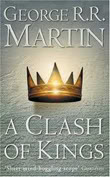
A Clash of Kings: To the north beyond the wall the wildlings are amassing behind a man known as Mance Rayder, the so-called King-beyond-the-wall, as they prepare to attack the wall and infiltrate Westeros. All that stands in their way is the weak army of the Night’s Watch, as this small number of the men in black with Jon Snow head out to put a stop to them. In this saga, Snow will learn of this Mance Rayder, as well as one of the wildlings whom he becomes close to.
Far to the east across the waters, Daenerys Targaryen continues to rebuild her own army in a bid to take back the kingdom of Westeros and her royal lineage. She travels with her consort to the renowned trading city of Qarth where she will face the ultimate test with powerful warlocks and the House of the Undying. Meanwhile her three dragons continue to grow and become stronger and more deadly.
And in the heart of Westeros the war rages on. Young Joffrey is arrogant, cruel, and impetuous, feeling he is in his birthright to be king of all the lands, while rumors run amuck of an incestuous relationship spawning this possibly illegitimate ruler. Joffrey rules from King’s Landing with the might and support of the house of Lannister. To the west is Robb Stark, the King of the North, looking to unite his lands and protect his people. So far he has never lost a battle, but gains little ground in the ongoing war. On the island of Dragonstone sits Stannis, the eldest brother of the surviving Baratheon family, feeling he is the rightful heir, while advised by the red priestess of R’hllor, Melisandre. His biggest contender is his younger brother who currently holds Storm’s End and the larger army. And finally, to the far west on the Iron Islands, a new contender decides to take the stage and declare himself king, one Balon Greyjoy.
But it is not these squabbling kings that keep readers hooked, but Martin’s work in diverse viewpoints from unique, unforgettable characters that you either learn to love or hate or perhaps both. Over hundreds of pages, readers begin to hate those they loved, while loving those they detested, as Martin swings his unstoppable scythe pendulum, not knowing who will come beneath the blade next. A Clash of Kings culminates with a mighty battle at King’s Landing that will leave many dead and a world in shambles, as the survivors look once again for personal gain, while readers will be left hungry for more.
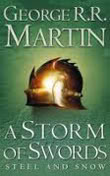
A Storm of Swords: To the north Jon Snow has infiltrated the wildings, looking to get close to Mance Rayder, the king-beyond-the-wall, and find out when they plan to attack the Night’s Watch, but he will find his loyalties challenged as he must fight and decide where his allegiances lie. Then there is the storyline of Bran, one of the Stark children, who is traveling to the north to find his brother. Theon Greyjoy now controls Winterfell through lies, deception and competing against his more popular sister for the love and support of his father, King Balon Greyjoy. Meanwhile, Arya Stark continues to get pulled back and forth from bad character to worse character, but because of her smarts and cunning she is able to scrape through alive. Jaime Lannister is let go to travel back to King’s Landing under the protection of Brienne of Tarth with the hope that the Lannisters will free Sansa Stark.
As for the war, things are not going well, but then that really depends on whose side you’re on. Robb Stark continues to win battles but make little headway in the war, but after falling for a girl who looks after him when he is wounded and marries her, he must meet with the Freys to soothe their relations. His uncle, Edmure Tully, will wed one of the Frey daughters and all will be well, it is hoped. Robb’s mother, Catelyn, doesn’t trust Lord Walder Frey, as she travels with her son, grieving over the loss of her father. But the Tully’s have something fiendish in store for them. Meanwhile in King’s Landing Joffrey rules in his cruel, childish way, while his uncle Tyrion, the dwarf, continues to fight with his sister, Joffrey’s mother, Cersei; then their father, Lord Tywin, arrives to upset the balance and organize things in his own way.
Far to the east, Daenerys Targaryen returns to Pentos by sea in search of an army. She finds one in the Unsullied, a slave army, but she must give over one of her dragons for the thousands of slaves. Daenerys has a plan and soon has her army which she immediately frees from slavery, making them unstoppable soldiers who will never defy an order. As she travels across the land, looking to grow her army and power and create peace among these peoples, she discovers two of her closes retinue are traitors and must decide what she will do with them.
A Storm of Swords is Martin at his best, as the events and actions that have been building in the previous books are brought to a harsh fruition, and the author continues to reveal what makes his series so unique. Some character storylines go on for too long and could use some heavy editing to shorten them down, or perhaps have been cut entirely as little seems to happen, while others are simply riveting, even when involving two character viewpoints covering the same event. At the end, just as with the first two books, readers will be left impatiently wanting more.
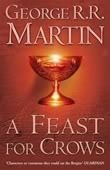
A Feast for Crows: Readers of the first three A Song of Ice and Fire books – A Game of Thrones, A Clash of Kings, and A Storm of Swords – will notice a trend with them: the page count is steadily increasing with each book. It seems like there must be a breaking point when it simply won’t be possible to bind that many pages into one book . . . well, that’s exactly what happened with the fourth book of A Song of Ice and Fire. George R. R. Martin was given an ultimatum from his publisher that the book needed to be divided into multiple volumes. The resulting A Feast for Crows only features a limited number of the main characters readers have become familiar with in the earlier books, as well as a number of newer ones as further lands and parts of Westeros are explored and revealed for the first time.
The War of the Five Kings is coming to a close, as many of the rulers readers have come to know are now dead, or fled for their lives. King Tommen now rules at King’s Landing, though under the guise of his mother, Cersei Lannister, who has finally gotten her lifelong wish to rule the realm. She fills her cabinet with loyal elders who soon fail in their duty and she becomes ferociously angry, suspecting and suspicious of everyone, driving herself to incessant drinking. Then there is Margaery Tyrell, who is married to her son, the king, who she believes is looking to take over the realm as queen and do goodness knows what.
Meanwhile, Jaime has had enough of his sister and leaves to make what reparations he can to the kingdom, to regain control over the Riverlands in the name of Lannister and the realm. Brienne is in search of Sansa, to free her from whatever perils she is in, fulfilling an oath she promised. In the Eyrie, Sansa remains seemingly trapped by Littlefinger who conducts himself in a very strange way with her. In the Iron Islands, the king Balon Greyjoy is dead by a freak accident, and now begins the long and laborious process of choosing a successor, as Balon’s children come home to claim the throne, including his tough and determined daughter, Asha. Far to the south, in the lands of Dorne, unrest is stirring as new contenders look to play a part in taking the throne, through Myrcella Baratheon who is told she has every right to the throne as her brother Tommen does. Finally to the east is Arya who is learning and training in the ways of the people of Braavos, while Samwell Tarly travels on his own journey to Oldtown to become the new Maester for the Night’s Watch, and travels to Braavos along the way, meeting with Arya.
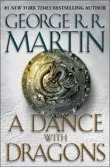
A Dance with Dragons: In the North, around the Wall, King Stannis Baratheon seems to spend a lot of time trying to decide what to do with no real power or army to use, while listening to Lady Melisandre, who continues to spout enigmatic prophecies that make little sense; yet readers do get to enjoy a chapter from her viewpoint for the first time. Meanwhile, Jon Snow is elected as the 998th Lord Commander of the Night’s Watch, as he must deal with not just enemies beyond the Wall, but also amongst the very men he leads and is in charge of. He works with the wildlings, bringing them south of the wall to bolster his forces in preparation for a possible attack from the Others; it seems to be an interesting act of diplomacy, but goes on for far too many pages, with little action or continuing story taking place.
Much of the rest of the book takes place to the far east. Martin has provided a couple of new maps, but nothing so clearly defined and comprehendible as the great continent of Westeros. Tyrion flees to Pentos, drowning himself in wine. He is forced to join with a group traveling to Meereen, along with the apparently not so dead prince Aegon Targaryen. Tyrion – as he always does – manages to get involved in a whole variety of adventures, including the meeting of another dwarf, and a female no less!
Daenerys is the character that seems most put through the ringer in this book; much like Cercei was in A Feast for Crows. She is no longer the tough, proud, defiant woman that everyone feared, and not just because she has three growing dragons. Having conquered Meereen, she should be the unstoppable, unquestionable queen that she is, and yet insurrection is afoot and Daenerys cannot seem to decide what to do; perhaps it is because she has become obsessed and besotted with one of her soldiers and seems to be able to think of little else when he is nearby, and yet he is of lower class and cannot possibly be her husband. The black dragon, Drogon, meanwhile is running rampant through the countryside as growing “teenage” dragons do, and Daenerys has no idea how to control him.
Finally there is Quentyn Martell, Prince of Dorne, whose story comes from nowhere as we follow his trek across the lands to Meereen, where he hopes to woo Daenerys by enslaving one of her dragons. It does not end well for him. Interspersed throughout the lengthy book are other POV chapters from the likes of Bran Stark, Davos Seaworth, Reek (who is in fact the very not dead Theon Greyjoy), Arya Stark, Victarion Greyjoy, as well as some surprise cameos from Jaime and Cercei Lannister.


Bookbanter Column: Get Lost in a Good (Urban) Fantasy Series, Part 5: October Daye (August 31, 2012)
Seanan McGuire published her debut novel and first in the October Daye series, Rosemary and Rue, in 2009.
She now has an impressive nine books out in just three years with the tenth due out in September.
She has perhaps become better know for her zombie horror trilogy, with Feed, Deadline and Blackout under the pseudonym Mira Grant, but her urban fantasy series is a classic example of the genre with interesting and engaging characters, thrilling supernatural mysteries, plus it’s all set in the San Francisco area, so locals will love it.
Think Harry Dresden, but make him female, set her in San Francisco, and accept that the world of Faerie not only exists but has portals linking to our own world and the characters of fable are very real and terrifying.
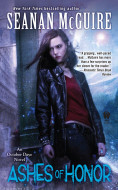
McGuire will be releasing the sixth October Daye book, Ashes of Honor, on September 4.
Rosemary and Rue
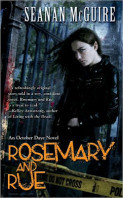
October Daye is a changeling (half-human half-fae) who has never really felt she belongs in San Francisco, or the realm of Faerie for that matter. A private detective, who seeks to help out her kind when they are in trouble, has her world changed when she is turned into a koi fish in the opening pages of the book and finds herself trapped beneath the waters for fourteen years and six months. The spell finally breaking, she returns to a very different San Francisco. While she attempts to acclimatize to this future world, a high ranking elven lady is found murdered, and as Toby investigates she finds herself magically bound to the woman until the mystery of her death is solved.
A Local Habitation

As Toby tries to settle down, licking her wounds from her last escapades in Rosemary and Rue, she is asked by her liege, the Duke Sylvester Torquill of the Shadowed Hills to check on his niece, Countess January O’Leary of Tamed Lightning, better known as Freemont, as he hasn’t heard from her in some time. Taking a sidekick along – Quentin — to show him the ropes, she finds herself caught up in way more than she bargained for.
Arriving at Tamed Lighting, Toby finds what appears to be a simple company that produces computer fantasy games, except that all the employees aren’t human, in fact there’s not a single regular human that works there. Then there’s the quiet way everyone acts around her, as if they’re hiding something. Then the first person turns up dead. As Toby unravels the mystery, it turns out bodies have been piling up, but when she tastes their blood to find out what happened to them, she gets nothing. They are empty husks with no story to tell of their demise. The mystery grows further when Toby finds herself under attack from someone or something.
An Artificial Night

As half-fae Toby recovers from her previous near-death escapade, she wonders if she might have some time to do some normal, everyday things, but soon receives a knock at the door.
It’s her Fetch, Maye Daye, a special doppelgänger that can only exist if Toby’s death is quickly approaching. Wondering where her day will go next, she soon receives news that the ceremonial hunt is now on: Blind Michael, lord of the Wild Hunt, is looking for new recruits; only his methods for acquiring them are unorthodox to say the least: he kidnaps them.
Toby finds out that Blind Michael has kidnapped a number of fae children and human children, some of them she is very close to.
There are only certain roads that can take her on this mission to the world fae and the lands of Blind Michael; each of them takes a toll. Toby enlists the help of some unusual allies: Tybalt, Lord of Cats; the Luidaeg, an offspring of Oberon and sibling to Blind Michael; Lily, a powerful fae of the Japanese Gardens in San Francisco; and her fetch, Maye Daye. And it is in Blind Michael’s lands that she meets another unusual character who has a strong connection with someone important in Toby’s life. Also it seems like this Tybalt guy who Toby has always had to hold her own against, may in fact not be such a bad cat after all.
Late Eclipses
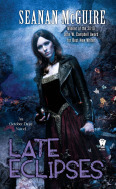
Toby’s still alive and well – relatively speaking – living with her fetch (summoned due to her apparently approaching, imminent death), her rose goblin, and her cats. Just when it seems like she might have a moment to herself, she is unavoidably summoned to appear before the Queen of Mists, who has always borne a grudge against Toby, who isn’t looking forward to this meeting. In a surprise that shocks Toby more than anyone else, the Queen promotes her to countess.
Suspecting a conniving trap, Toby finds herself drawn across San Francisco from place to place as her dear friends and loved ones begin to fall ill due to a mysterious sickness, including Lily, Lady of the Tea Gardens and Lady Torquill of the Shadowed Hills. As she scrambles around trying to find a cure and who’s behind all this, the hammer falls and she finds herself accused of this sickness and people are starting to die. Then she starts seeing Oleander de Merelands, one of the two people responsible for trapping her in a pond for fourteen years of her life; only it seems like she’s the only one seeing her.
Meanwhile, things between Toby and Tybalt, the King of Cats, begin to heat up. But Toby will save everyone and fix everything . . . right?
One Salt Sea

Another day, another big problem to solve for October Daye.
This time someone has kidnapped the two sons of the regent of the Undersea Duchy of Saltmist. Only a month has passed since Toby was brought back from the brink of death and Oleander de Merelands was defeated in Late Eclipses, and now she has a whole new place to call home – Goldengreen – and to deal with. But she has these kidnappings drop into her lap, and she only has three days to do it or it will be all out war between the sea fae and those on land, which is not a good thing, as the saying goes: “When Faerie goes to war, not everyone will walk away.”
Using some help from the terrifying sea witch, the Luidaeg, who creates a spell, Toby is able to breathe underwater and here McGuire has fun with some great description of strange and unusual and fascinating underwater fae that makes The Little Mermaid seem colorless and boring. But Toby knows she’s on a deadline and needs to find any clues she can, put them together, and find these missing kids before it is too late.


Bookbanter Column: Get Lost in a Good Fantasy Series, Part 4: The Inheritance Trilogy (August 17, 2012)
There have been lots of fantasy books written about gods and goddesses; plenty about heroines and heroes; and some about a world of class differences and the haves and have-nots; but very, very few about all three together.
Welcome to The Inheritance Trilogy and a look at N. K. Jemisin in her debut series, where she combines all these elements in a fascinating world with diverse and interesting characters, as well as a thrilling plot.
The Hundred Thousand Kingdoms
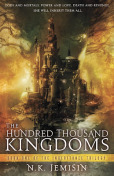
From the barbarian north, Yeine Darr is outcast and would like nothing more than to live an ordinary, normal, quiet life; but when her mother dies from mysterious circumstances, and she finds herself summoned by the Arameri patriarch (her grandfather) to the spectacular capital city of Sky, she knows normalcy is something she will never be able to have. Dakarta, her grandfather, has proclaimed her an heir to their throne, though she is pitted against two cousins who want the throne much more than she, and will stop at nothing to get it.
She doesn’t expect to survive the week.
But as Yeine gets to know the people of Sky in her run for the throne she discovers it is a place that is anything but ordinary.
The gods are now forced to live in the beautiful city, as servants, due to losing an ancient war. Yeine makes friends and allies, but also enemies in this political concoction, and will need to use her strengths as a woman as well as her status if she is to make it through. While the ending leaves the reader somewhat unsatisfied after the heavy buildup, The Hundred Thousand Kingdoms is a great new voice in fantasy fiction that reveals a new and different world, with some fresh fascinating characters.
The Broken Kingdoms
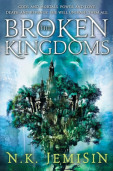
Oree is blind, but has the ability to see magic and people with magic abilities, such as the gods and godlings. She spends her days creating original works of art with her special abilities in the city of Shadow beneath the towering World Tree. Oree gets by with the selling of her work and is able to navigate around the city with little problem. Then she discovers the corpse of a godling in an alley; after a cursory examination, she soon finds out that the godling has been murdered. She begins her investigation to find out who did it, while two groups begin pursuing her: one is a fanatical religious group looking for a scapegoat to blame for the murder; the other can only be the people behind the murder.
The Broken Kingdoms is a surprising second book to the trilogy, as it has little to do with most of the original characters of The Hundred Thousand Kingdoms, and is set a decade later. Yet, perhaps it is this which makes The Broken Kingdoms that much more interesting and compelling, as it is another story in this distinctive world from a completely different viewpoint and storyline.
The book is a welcome sequel that reveals Jemisin’s talents as a writer both with strong characters and good plot, leaving readers anxiously awaiting the conclusion to the trilogy.
Kingdom of Gods
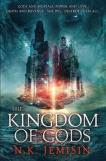
Readers became familiar with the childishly cute and trickster godling, Sieh, in The Broken Kingdoms.
In The Kingdom of Gods, readers get to experience and enjoy this wonderfully detailed and complex world from the viewpoint of this powerful being. Beginning with a playful introduction as Sieh behaves like the godling he is, playing with children’s minds, satisfying his own whim. There are two youngsters he fixates on: the beautiful Shahar, next in line to rule, and her twin brother Dekarta, who is young and powerful in his own right. Then a freak accident occurs as all three join hands and Sieh attempts to use his godling power.
When Sieh awakens, the godling is alive but weak.
Returning to Shahar and Dekarta, he discovers that much time has passed and they are now teenagers. Also the godling soon notices there is something very wrong with him: he is aging, growing older, like a human. The gods that conceived him are unable to stop this process and he must confront this new fate, as well as work with Shahar and Dekarta as they face the approaching evil, the Maelstrom, which will consume the entire world.


Bookbanter Column: Get Lost in a Good Fantasy Series, Part 3: King Raven (August 3, 2012)
Pretty much everyone is familiar with Robin Hood in some way, whether it’s thanks to the wonderful Disney movie (still my favorite!) or various stories heard as a kid, or the well-known old text by Robert Pyle, or the various movie versions of this enigmatic figure, shrouded in history and intrigue.
We all know the basic story of this unusual hero coming from very little, living out in Sherwood Forest with his band of merry men, robbing from the rich to feed the poor.
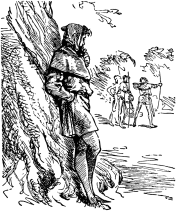
But for the most part this story is one of invention and imagination, as there is very little evidence to support this.
Stephen R. Lawhead, bestselling author of many books including his Song of Albion series and his Pendragon Cycle, does something a little different in his King Raven trilogy, pulling from various sources and melding a world of eleventh century turbulent history and Welsh mythology. It is again very much a what if, but one steeped in research, making it a fascinating read.
It also, perhaps for the first time, puts Robin Hood on an epic stage with these three long and detailed books, giving this mysterious character of history the recognition and respect he deserves.
H ood
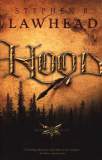
There are a couple of “legends” in British history that many people worldwide know about: one of them is King Arthur and the other is Robin Hood.
Arthur has an entire bookshelf of history and fiction written about him, and many of those fiction books profess to be as accurate as the possible truth, even though it is still not fully known if there ever was such a living person. As for Robin Hood, much of the same story and lore shrouds this figure, and yet the amount written about him is small in comparison. There are many seminal works that are considered part of the “King Arthur Cannon,” such as Malory’s Morte D’Arthur, Chretien de Troyes romances, Marion Zimmer Bradley’s Mists of Avalon, Bernard Cornwell’s Warlord Chronicles, and Jack Whyte’s Camulod Chronicles, to name a few. In fact the author, Stephen R. Lawhead, has even written a series about Merlin and Arthur, known as his Pendragon Cycle. There have been mediocre to poor TV shows about he who robs from the rich to feed the poor, but there has never really been an equivalent book series or trilogy about Robin Hood of a high caliber; until now.
Bran ap Brychan doesn’t really know if he ever wants to be king, but his father is a poor monarch who doesn’t treat his subjects of Elfael as well as he should perhaps, but then Bran doesn’t really know what he wants to be. Then all that changes when a group of Normans invade the Welsh kingdom and his father is killed, making Bran the automatic heir. Except the Normans seize the kingdom, awarding it to a bishop and care little for Bran and his supposed claim to this throne. And so begins Bran’s adventure, as he brings together a band of merry men to go see King William and wrest back his kingdom. Thwarted in London, he is told he can have his kingdom back for a ridiculously high amount of money. So Bran sets about getting the money the only way he knows how: from those cursed Normans who stole his land, as well as making sure his people are treated right and well.
Stephen Lawhead presents the first of his impressive trilogy on Robin Hood in Hood, explaining his detailed research in the afterword, and pointing out the unlikelihood of this character living in the thirteenth century in Sherwood Forest and going against King John. Lawhead posits Robin Hood living in the late eleventh century in the time of William the Conqueror and his overtaking of Britain with his Normans. Bran is a Welshman, and the Normans cared little for this distant part of Britain, except when they wanted to make it their own. It makes perfect sense that a man out of legend would rise up to help the people against those dastardly Normans. Lawhead also pulls from Celtic mythology to seamlessly blend with the story. Hood is a great and riveting work of historical fiction that will have any fan of the genre hooked and wanting to read more in the trilogy.
Scarlet
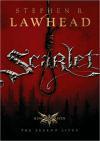
The book opens with the framing tale of Scarlet, who is in prison and sentenced to be hanged.
In the brief time before his execution, Scarlet tells his story of losing everything and becoming a forester where he meets this King Raven. At first challenged to an archery contest, he reveals his extreme skill, rivaling that of King Raven, better known as Bran, and soon becomes a valuable member of his “merry men.” But Bran needs a skilled warrior like Scarlet to fight back against these Normans steadily taking control of Wales, as William the Red doles out more land to his cutthroat barons.
The book comes to its climax as Scarlet must choose whether to be executed, or to give up the secret location of King Raven and his men.
Tuck
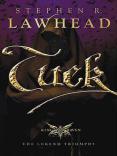
In Stephen R. Lawhead’s conclusion to the King Raven trilogy, readers get to enjoy it from the viewpoint of the jolly and redoubtable Friar Tuck, who has been around since the first book, Hood, and on through the second, Scarlet.
But little has been seen in the abilities of this clergyman, until now, who is bravest and shines brightest at his most important moment.
It seems the Normans simply won’t give up, and King Raven, also known as Rhi Bran Hood to the people of Wales, must muster not only his skilled foresters, but incite an entire revolt from his people, based mainly in his kingdom of Elfael. With the treacherous Abbot Hugo and the evil and bloodthirsty Sheriff de Glanville, it will take everyone working together to bring these Normans to their knees once and for all and send the firm message to King William the Red that King Raven and his Welshmen will not be crushed.
Lawhead rounds out the trilogy in a great way, bringing it all to a satisfying close, but still with plenty of action and subplots and complex goings on. Again blending the history with the Welsh mythology, it is a very enjoyable read seen through the eyes of a new character.
If Hood was the tasty appetizer, and Scarlet the delicacy of a main course, then Tuck makes for a delicious and perfect dessert.


Bookbanter Column: Get Lost in a Good Fantasy Series, Part 2: The Riyria Revelations (July 20, 2012)
Some years ago, author Michael J. Sullivan began writing a fantasy for his daughter: a story that she would enjoy hearing, but also one that he would enjoy reading.
It eventually turned into a six-book epic fantasy series that was published through an independent press.
What was perhaps most unique about the Riyria Revelations was that Sullivan had all six books completely plotted and planned to serve as individual, stand-alone novels, but also linked together into a long series.
The series slowly but surely gained momentum and a following, as more readers and fans were discovered, and the books received more ratings and reviews on the likes of Good Reads and Amazon, and Sullivan received more and more interview requests, including with yours truly.
His popularity and success grew to such a point that after the release of the fifth book in the series, Sullivan finally got that big publishing contract with Orbit Books, who released the series in three volumes late last year and early this year, with two books in each volume.
This is the story of two thieves who change and grow and develop through each of the six books, as readers become so attached to them that by the end they feel like family. It is also the story of what heritage and history means, and that the past is never truly gone, but also that sometimes these things don’t have to matter as much as people think they do, and it’s important to enjoy life however you can.
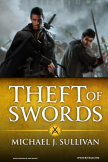
Theft of Swords: In The Crown Conspiracy our main characters are nothing but low-life thieves: Royce Melborn and Hadrian Blackwater, although they’re very good at their jobs. The story begins with the introduction of these intrepid characters and their next heist to steal a particular item within the impenetrable confines of the king’s castle. But as soon as they have their hands on the item, the trap is sprung, and they find themselves part of an elaborate plot. At their feet lies the lifeless body of the king.
From here, the story kicks into high-gear, taking the reader on a wild ride. In this world it is important to know who your friends are and who are your enemies; it is also important to keep your enemies closest. As the story unfolds, we learn that while they may be common thieves, they are very smart people. They also realize that the idea of being a good person is starting to rub off on them, as they no longer do anything for a fast buck.
By the end of the book, everything seems to have sorted itself out. Royce and Hadrian are now doing very well for themselves, as well as being close friends of the king. But clearly all is not as it should, since this is the first book in the series.
In Avempartha, our intrepid duo returns in the second installment of The Riyria Revelations to solve another mystery and fight another day.
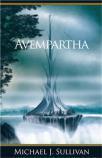
Before Royce and Hadrian barely have time to settle after the fun had in The Crown Conspiracy, they find themselves pulled into a new problem: a young woman needs their help as her village is being attacked by an unknown nocturnal creature.
The town of Dahlgren is an idyllic place, except now it is visited each night by an ancient monster looking to terrorize and kill everyone. Royce and Hadrian know they can’t take on this beast by themselves, at least not without some impressive magic, and call on the help of their old friend and brilliant wizard, Esrahaddon. Hadrian does his best to protect the town and its people, fortifying it, and having everyone hide out in the fortress each night. Meanwhile Royce and Esrahaddon journey to the ancient elven tower known as Avempartha. There they hope to confront the beast and kill it. But everything doesn’t go according to plan, as it never does, and Hadrian learns some very important things about himself.
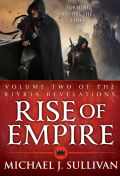
Rise of Empire: In Nyphron Rising, things take a turn for the worse as war comes sweeping through to Melengar and its people have little hope and respect for their recent, young king. Princess Arista has been running around playing diplomat and trying to secure allies for Melengar, with nothing to show for it. Meanwhile the enemy Nyphron Empire continues to grow in strength and numbers. Arista has one more trick up her sleeve, and with the help of her good friends, Royce and Hadrian, goes on this last journey far south in a last effort to secure an ally, but also to unravel a mystery of Hadrian’s past. Surprising results are revealed about our unknown thief that ties into the whole story of the Riyria Revelations. The wizard Esrahaddon continues to be up to no good, while we learn more of the enigmatic man known as Degan Gaunt.
Sullivan does a great job with Nyphron Rising, after setting necessary groundwork and story and setting with the first two books, he opens it up on an epic scale, traveling his invented world, and educating readers on how future events are going to affect everyone across Elan, and why the forgotten history is important. Royce and Hadrian continue to be the entertaining and interesting characters that they are, while Arista opens up her emotional side.
With the events of Nyphron Rising now at a close, the elusive duo, Royce and Hadrian aren’t sure what do to next. Royce has plans to retire and relax, settle down with his lady love and enjoy the rest of his days, while Hadrian has dark shadows of his past and heritage to confront and accept, while deciding he is on a mission to find the lost heir of Novron. It takes Royce all of three seconds and little convincing to decide that Hadrian won’t last long without him, and together the two set out, following the clues that lead them to the mighty trading vessel, the Emerald Storm. They know nothing of seamanship and what to do aboard such a large vessel, but knowing one of the crewmen, they’re able to get added to the crew and begin the journey through the mysterious and interesting lands of Elan. Naturally, there is lots of adventure on the high seas, not to mention some strange guests on the Emerald Storm, as well as the enigmatic cargo. Meanwhile an important subplot is furthered along with the princess, who is bored with her station, looking to make her life more interesting, and gets some answers.
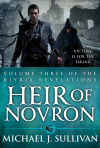
Heir of Novron: In Wintertide, on this year’s holiday of the same name, a special celebration has been planned. The New Empire wants to make a big deal of its victory over the Nationalists, and has some important public executions planned: the villainous Degan Gaunt and the Witch of Melengar. The only problem is that Royce and Hadrian are in town and they happen to be good friends with both of those people and have plans of springing them free whatever it takes.
Sullivan clearly had fun with Wintertide, playing around with Hadrian engaging in a joust, even though he doesn’t know much about the whole nobility and chivalry thing, but he sure knows how to fight. And how having friends in the most unlikeliest of places often proves invaluable. Fans will enjoy this penultimate chapter, with Sullivan’s strong descriptions and scenes of the winter festivities; of the sounds, sights and smells. It’s an enjoyable, thrilling tale before the final showdown.
In Percepliquis, the beginning of the end has begun: the elves of old have crossed the Nidwalden River in large numbers and are coming to take over; they threaten the entire continent of Elan. The people have little hope left; they know they don’t stand a chance against these powerful elves. And it all comes down to Novron’s heir, who must make a stand, and the only way he can do that is by finding the sacred horn. It will involve an arduous quest, with a strong group of warriors who also possess intellect. They will have to travel deep beneath the ground, in search of the ancient, ruined city of Percepliquis, following an old diary that may not even be true. Fortunately, Royce and Hadrian are coming along for the ride, so if these intrepid few have any chance of finding the horn and saving the people of Elan, only these two will be able to make it happen.
In the longest volume yet, Sullivan has outdone himself here with lots going on: multiple storylines, lots of action, lots of conflict between friends and enemies, important details from the previous books brought to light, travels through various terrains, and an ultimate duel. With the thrill of a top-rate action movie, combined with the epic grandeur of Tolkien’s Return of the King, this is a final showdown you won’t be able to stop reading, let alone put down. Who will live; who will die? In this grand finale, anything can happen . .. you won’t want to miss it.


March 11, 2013
Book Report: Subway Libraries, Best Bookstores, Van Halen & More!
The World’s Great Bookshops
Lonely Planet on the world’s best bookstores you don’t want to miss.
What Does the Future Hold
Rachelle Gardner on the future of books, authors, publishers and writing.
B&N’s Pick for March
Barnes and Noble presents its top booksellers picks for March.
Subway Libraries
A novel new way of finding out about books and which libraries carry them.


March 8, 2013
“The Demonologist” by Andrew Pyper (Simon & Schuster, 2013)
In this new dark thriller, along with elements of horror, Andrew Pyper, author of The Guardians and Los Girls, presents a tale that is perhaps best described as The Historian meets The Exorcist, blending a world of history and symbolism and meaning with one of demons and sheer terror. If Dan Brown were to pen an outright horror novel, it might look something like The Demonologist.
David Ullman is a college professor who specializes in Christian religions, myths and symbolism; he is also one of the foremost scholars on Milton’s Paradise Lost. With a failed marriage, apart from his teaching all he truly cares for in his life is his wonderful daughter. When he is mysteriously offered a free flight and stay in Venice to attend a certain meeting employing his expertise as a “demonologist,” he is very reluctant at first, but then decides to go and give his daughter a short vacation in beautiful Venice. At the meeting with a stranger he sees something that shouldn’t be possible, that isn’t possible he tells himself. Fleeing in terror he finds his daughter speaking in the voice of one he has read about and studied in many books, before she jumps from the roof of a high building. Now he begins his true quest, to hunt down the origin of this voice and creature and with hopes to get his daughter back somehow.
The Demonologist is a balance between an interesting professor waxing about the greatness of Milton with plenty of quotes throughout and thrilling, terrifying action scenes as Ullman confronts what can only be called a demon inhabiting a human form, and he is on the run. The symbols and meanings seem a big stretch to reach at times, but ultimately lead the character to where he needs to go. As the novel progresses, things get a little uncanny, which might lose some readers, but Pyper brings them back to home in the end with an intense but satisfying conclusion.
Originally written on July 15, 2012 ©Alex C. Telander.
To purchase a copy of The Demonologist from Amazon, and help support BookBanter, click HERE.

Bookbanter Column: Get Lost in a Good Fantasy Series, Part 1: The Mistborn Trilogy (July 6, 2012)
Finding a good epic fantasy series to read can sometimes be a troublesome thing.
There are a number of them out there that go on for a number of books, ranging from the trilogies to five-book series to ten-book series and beyond.
I’ve tried a number of them myself, and it can be hard to assess whether any of them stand up to say the holy trinity trilogy of The Lord of the Rings.
A number of them start out strong, and then eventually devolve into redundancy and boredom, such as Robert Jordan’s Wheel of Time, while others just lose their way after the first three books; Song of Ice and Fire, I’m looking at you. Now, these are just my opinions, and I know there are many many readers who would disagree with me, but there is one particular trilogy I know most epic fantasy fans can agree is excellent from start to finish, and that is Brandon Sanderson’s Mistborn trilogy.
The series has in fact continues sell very well and is so popular that an RPG is now in development for it. And while the trilogy is complete with The Final Empire, The Well of Ascension and The Hero of Ages, Sanderson has announced that he’s not done with the world by any means and has plans to write two further trilogies set within this world, though further in the future, a good example of which is his recently released Alloy of Law.
What can be best said about the series, other than the fascinating world, the interesting and complex characters, and the riveting plots, is that the magic system is simply mind-blowing.
And perhaps what makes the magic system so impressive is that it strongly adheres to what has colloquially become known as Sanderson’s Law: “An author’s ability to solve conflict with magic is DIRECTLY PROPORTIONAL to how well the reader understands said magic.”
The Final Empire:
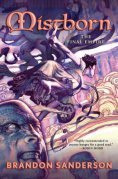
Vin is a sixteen year-old skaa, a peasant girl who has never really known her parents, abandoned by an abusive brother, and spends her days working in a field with no hope of change. That is until a tall and imposing stranger by the name of Kelsier shows up, dismisses her abusive boss like he is garbage and pays attention to her for the first time. He tells her she possesses powers she is unaware of and then takes her away from her life of slavery, for she is mistborn.
The mistborn are very few in number, but the powers they possess are to be feared by many throughout the realm. By ingesting small amounts of metals, a mistborn is able to “burn” a particular metal and exert a certain kind of power with it, also known as an allomancer. Different metals that are burned result in different powers. Steel allows one to push on metal objects such as railings, doors, coins, belt buckles, wherever there is metal nearby to be used, allowing one to push themselves into the air to great heights. Iron allows one to pull on metals in one’s surroundings, pulling them up walls and across open spaces. Zinc allows the mistborn to inflame emotions in others, to make them angrier or sadder, or more fearful. Brass is a soothing metal, allowing the user to calm and dampen other’s emotions. Bronze allows the mistborn to detect whether allomancy is being used by others nearby. Copper allows mistborn to hide their use of allomancy. Pewter, one of the most useful of the metals for an allomancer, allows them to greatly enhance their physical abilities, so they can be stronger, have faster reflexes, and move exceedingly fast. Pewter also allows them to sustain injuries and barely notice the pain and not be hindered when under attack. Tin enhances one’s senses, allowing them to detect sounds, sights, and smells better than any human. These are the basic metals that all mistborn can use. But when the small supply of ingested metal is extinguished, the allomancer must find more, or find themselves with simple, ordinary human abilities.
Then there is the metal atium. A very rare metal that can only be found in small amounts within the crystalline caves of the Pits of Hathsin. It is here that prisoners are put to work to search for the metal and suffer constant wounds from crawling through the narrow tunnels. If the prisoner does not find a piece of atium, he or she is executed. Atium serves as the most expensive metal in the realm, which everyone hungers for. The Lord Ruler gives out small amounts to his nobles and keeps the rest for himself. But when a mistborn swallows and uses atium, they have the ability to see future actions, choices made by an opponent during a fight, making it the most important and useful metal for an allomancer.
As Vin begins training with Kelsier, who is also a mistborn, she discovers she is to be part of a group plotting to overthrow the Lord Ruler, who has controlled the world for over a millennium, subjugating all to his tyrannical and merciless power. With the help of the religious group, the Steel Ministry, which is controlled by the Inquisitors: a trained and bred group of people with giant spikes hammered into their eyes; they are feared by all for their terrifying appearance, as well as for their allomantic abilities.
But there are those – Pewterarms, Seekers, Soothers, Rioters, Lurchers, and Coinshots – who are able to use only one of the metals, and Kelsier has chosen the gang carefully, selecting specific people with specific talents and powers, and fully believes he can kill the Lord Ruler and make the world better.
The Well of Ascension:
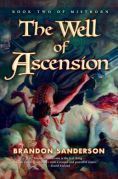
Before the dust even has time to settle, King Elend faces problems from various fronts: there is dissension in his democratically elected cabinet who wish to return to the old ways; then there are three armies marching toward Luthadel. Before our main characters can decide what to do, they find themselves under siege from two massive fronts. One is controlled by Lord Straff Venture, Elend’s father who wants his son to hand over his kingdom to him, no questions asked. Then there is Lord Cett looking to seize control of Luthadel with his own substantial army. Elend finds himself in a unique position where he can ally with one army and therefore be able to overthrow the other. The question is who to ally with?
As he contemplates this a third army arrives, of koloss. These are tall 9-15 feet creatures that vary in size but are terrifying to humans. Originally created by Lord Ruler for his army, their skin is extremely wrinkled and hangs off them in places like loose clothing while there are great tears in the skin and yet the koloss ignore this. But their red, blood-rimmed eyes strike terror in all who view them. They may seem dumb and slow, but in battle they are fierce and destructive, and it’s unknown whether they may lose control at any second and begin rampaging into the city of Luthadel.
Then there is Sazed, a loyal member of the group who is a Terrisman, a special person with the ability to store thoughts, memories, and knowledge in metal that is worn in the form of rings or armbands. Stored in these armbands are also other abilities such as great strength and speed. But in Sanderson’s world, it’s all about balance, as the energy stored in each armband is finite, and in some cases can take many years to be stored up, but can be used and extinguished in a matter of minutes. Sazed is a scholar and knows much is not right with the world. Somehow the mists that are feared by many for a long time throughout the realm begin killing people and even wiping out whole villages. There is the Deepness, a mythological force that was supposedly stopped when the Lord Ruler came to power, but is not fully understood and may bring terrible things to pass. Sazed must also find the correct location for The Well of Ascension, for it is here that the Hero of Ages – who he believes Vin to be – will release the power and save the world.
Then there is the OreSeur, a kandra, an ancient race who are able to absorb the bones of a dead person or animal and take that form and appear almost identical to them. OreSeur is Lord Straff’s kandra, and is sent to spy on Vin, but it’s also discovered that there’s another kandra somewhere within Luthadel who, with the kandra abilities, could literally be anybody.
Finally there is the supposed Hero of Ages, Vin, who isn’t sure what she is, but knows she is one of the most powerful people in existence, but must use her power wisely and not kill recklessly. She befriends another allomancer, Zane, who seems very familiar, and she becomes close to him, for they have so much in common, and yet he is the allomancer for Lord Straff and therefore an enemy.
The Hero of Ages:
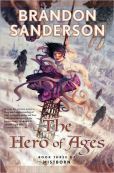
The Well of Ascension has been found by the supposed Hero of Ages, Vin, and the power has been released, except it is an evil spirit, Ruin, who seeks to end the world with the help of its deadly inquisitors. The ash from the ashmount is falling thicker and stronger, choking the lands, preventing life from growing or surviving, while the great volcanoes are beginning to thunder to life, and the mists continue to terrify everyone, leaving some dead, others deathly ill, perpetuating the mystery.
Elend Venture, now emperor of the realm has two kingdoms to ally with in preparation for the end and the oncoming battle. Leaving with Vin, he heads to Fadrex City which was formerly Cett’s kingdom, but is now under the control of the obligator Lord Yomen, along with his army of koloss. Spook, Ham, Breeze and others head for Urteau under the control of the maniacal Quellion. But Ruin is somehow able to control both Yomen and Quellion, as well as stealing control over the koloss, outweighing the odds against Emperor Venture and his people.
Then there are the mysterious kandra race who are in a crisis of faith, for their sole existence is based upon the Contract which was written by the Lord Ruler, who is no longer: does the Contract therefore no longer apply? There is the trial of TenSoon who has slain one of their own. The First Generation of kandra sit silent and undecided, while the later generations are anxious and impatient, unsure whether to adhere to the Contract or rebel.
Finally there is the great Sazed, the scholar who has lost his faith, having researched every religion but one and finding nothing but lies and obfuscation. It is with this last religion, the religion of his Terris people that is somehow tied to that of the kandra, that he holds on with a sliver of hope, seeking some final answers to the meaning behind the world, its gods, its peoples.
In The Hero of Ages, Sanderson ratchets everything up to its highest point, with the end times approaching and all hope dwindling.
The reader is hooked to the very last page, unsure of what will happen, who will survive, and wondering if this might really be the end of everything?








